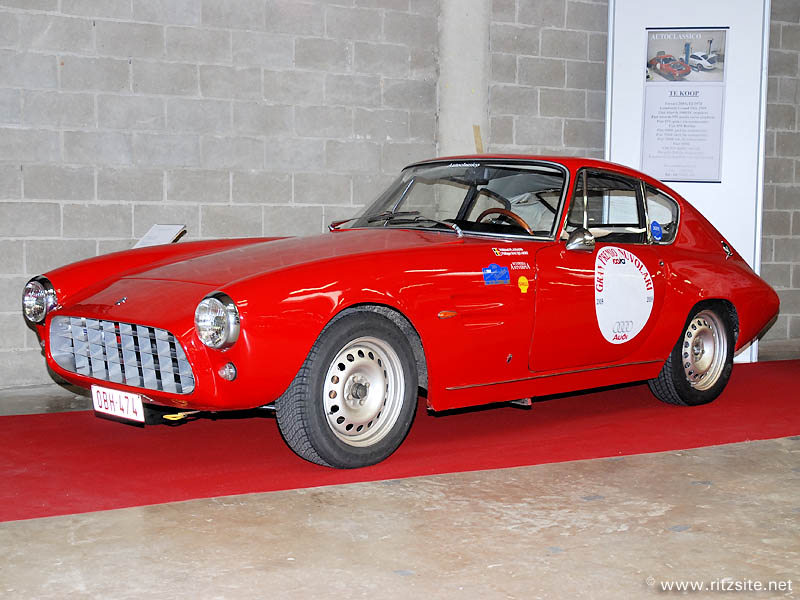|

Ghia 1500 GT Elaborata - coupe body - manufactured in 1967
Traditionally coachbuilders provide bodywork for cars made by other manufacturers but when orders diminished in the late 1950s and early 1960s some coachbuilders turned to car manufacture themselves. Especially Italian coachbuilders, of which the more prominent ones had already been an essential part in the process of car production, regarded that transition as a viable option to save their company. Some examples are the Pininfarina 124 Spider, a continuation of the Fiat 124 Spider, the Bertone Berlinetta 850 Racer, a continuation of the Fiat 850 Spider in several forms and the various Vignale models of which the Gamine spider is probably the best known.
Carrozzeria Ghia was another famous Italian coachbuilder which picked up car production. The company's history dates back to 1915 and is credited with many legendary designs like the Lancia Aurelia B20 GT and the Volkswagen Karmann Ghia. Unlike rivals like Pininfarina and Bertone it disliked to industrialize and sticked to traditional small scale production, which was the main reason that the profitable manufacture of the Aurelia B20 GT body was transferred to Pininfarina for instance and Volkswagen turned to Karmann for production. Ultimately this proved to be a problem for the company and the strategy was changed in 1961 with the Fiat 2300 S coupe, for which Ghia not only delivered the design but also produced the bodies. To fully utilize the new production facilities Ghia looked to expand their range and the decision was made to develop a small sportscar based on affordable Fiat components: the 1500 GT.
Sergio Sartorelli, head of the Ghia design staff, styled an attractive and modern fastback coupe which was powered by a Fiat 1481 cc 4-cylinder engine and constructed around a tubular frame designed and produced by Gilco based on a considerably shortened Fiat 1500 sedan platform. That Ghia also took the trouble of incorporating a purpose built chassis into their design was remarkable but proved that the company's attempt at becoming a car manufacturer was taken very serious. Gilco was the company of Gilberto Colombo and very experienced in creating chassis for Italian racing cars with that of the Ferrari 250 GT as most famous example. This ensured that the structure of the 1500 GT was of the highest quality, fit for use in competition.
The Ghia 1500 GT was introduced in 1962 and awaited a generally favorable reception; its lines were not liked by everyone with the steeply angled rear and the chromed "letterbox" grill in front mostly criticized, but overall it was regarded as an attractive and competent car. At 995 kg it was light and the tuned engine with Weber carburettors produced 84 hp @ 5200 rpm, enough for a lively performance and a top speed of 170 kph. It sold quite well for such a special car, about 846 have been made up to 1967 when production was terminated, though Ghia might have had higher hopes for it. Mainly the cars found their owners in Western Europe but some 36 of them were exported to the USA.
These results encouraged Ghia to develop an additional model, initially meant to replace the Fiat 2300 S coupe. At the 1964 Turin Motor Show the Ghia 230 S was unveiled, again based on a shortened Fiat floorpan and a purpose built Gilco tubular chassis. Its sharp lines recalled the Dual Ghia L 6.4, an exponent of the famous Chrysler Ghia show cars of the 1950s and built to order during 1960-1962, and it was 21 cm shorter than the Fiat 2300 S coupe had been. Unfortunately Fiat saw nothing in it and only a few prototypes were made. Chrysler however did like the car but insisted that it should be a convertible instead of a coupe. Ghia revised the design and fitted a 4490 cc (273 cid) Chrysler V8 under the hood and so the Ghia 450 SS was born in 1966. It was a very attractive and powerful car which was available as a hardtop and a roadster; it was also quite expensive and only 52 were sold.
Ghia's career as a car manufacturer ended abruptly in 1967 when the company was acquired by De Tomaso, a constructor of sportscars. Ghia then concentrated on producing bodies for the De Tomaso Mangusta, a Ford-powered supercar, and worked on its successor, the Pantera. At the time the Ford Motor Company had a keen interest in the Italian car scene and took Ghia off the hands of De Tomaso in 1970. This more or less spelled the end for Ghia as a coachbuilder. It's still active as a design studio within the Ford concern and its badges appear on luxury versions of regular Ford models, reduced to only a mere shadow of what Ghia once meant.
Currently Ghia produced cars are undervalued, mainly because not many people know about them. They're not rare however, many 1500 GT models have survived and are avidly used in classic car rallies and alike. Obviously the Ghia 450 SS is the more sought after model but the 1500 GT is gaining recognition. It has simple mechanics which are easy to maintain and unique looks, the only downside is the sometimes disappointing built quality of the cars. The one shown here is a bit modified (hence "elaborata"), most notably the grill has been changed into a more classic "egg crate" look while the original was a more angular chromed affair which protruded from the front. Still it remains a wonderful example of Ghia's short spell as a car manufacturer.
© André Ritzinger, Amsterdam, Holland
|
